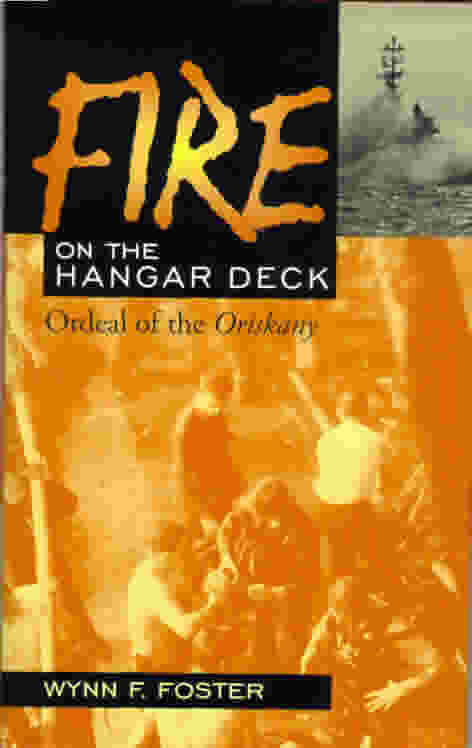
Fire in the Hangar
Book review by Fred Lane
Foster, W.F. (2001) Fire on the hangar deck: Ordeal of the Oriskany. Naval Institute Press: Annapolis. 175 pages including index, photographs and schematic drawings.US$26.95.
“Fire, fire, fire, fire in the hangar,” must be one of the most feared tannoy broadcasts ever in any ship that carries aircraft. It generates more anxiety in experienced aviators than the oft-called “Crash on deck”. With tonnes of volatile aircraft fuel, high explosives and aircraft oxygen nearby, it is almost axiomatic that more lives are about to be lost. The ship herself is in mortal danger. Only disciplined, fast and expert reactions can save a ship with a serious fire in the hangar. In the USS Oriskany fire, starting about 0720, 26 October 1966, many officers and sailors not only did the job they were trained to do, but also displayed superb individual and team initiative and bravery. This book by Wynn Foster should be required reading for every person in any ship operating an aircraft.
Wynn (Captain Hook) Foster, made two combat deployments in Vietnam aboard Oriskany, but was shot down in an A-4E Skyhawk and lost his right arm on 26 July, three months before the fire. His gripping account reflects his intimate knowledge of the ship, her systems and her crew. He also captures the drama of stark terror and confusion and the heroic responses to those challenges by his shipmates.
Essex class
Oriskany was an Essex class fleet carrier, modified to 27C standard, and nearly twice the size of the RAN Light Fleet carriers. She first saw action in Korea and in 1964, at the start of the Vietnam War, she was the youngest of the still-active WWII-era Essex class carriers.
In her 1966 Air Wing 16, she carried two squadrons of A-4 Skyhawks, one squadron of A-1 Skyraiders and two of F-8 Crusader aircraft. She also mounted detachments of E-1B Tracer AEW aircraft, A-3 Skywarrior tankers and UH-2 Seasprite SAR helicopters. She was on the second night shift, a midnight-to-noon operating cycle employing a 90-minute deck turnaround. At the time of the fire she was working up to launch her breakfast time 0730 strike.
Like the fires in Forrestal (134 dead, nine months later), and Enterprise (61 dead, 14 January 1969), the initial fire was probably caused by a breakdown in safety procedures, training and supervision. Bad weather cancelled Oriskany‘s scheduled night operations, so dozens of Mk 24 magnesium parachute flares and other ordnance were being unloaded from the night strike aircraft. A pair of young ordnance handlers were stowing the 25-pound flares into a ready use flare locker on the hangar deck when they inadvertently activated one. The seaman reflexively tossed the primed and hissing flare into the locker and slammed the door shut. Magnesium flares require no oxygen supply to burn, so the single flare ignited some 650 others in the ready use stowage locker.
Shared ventilation
The locker shared ventilation ducts with nearby officers’ cabins, so the resulting fireballs and explosions not only created havoc in the hangar, but also killed many officers in their cabin area. A total of 44 men died. At one stage the forward part of the ship, including the bridge, lost all electrical power (with 28 degrees of rudder on, of course).
“No great genius was required to deduce that under the pressures of round-the-clock combat operations, expedient departure from ordnance safety and handling was likely to occur,” says Foster (p 154).

The prescribed flare stowage in this essentially WWII carrier was unsuitable for the tempo demanded by Vietnam War operations. A ship-level decision to stow flares in a designated rocket-motor stowage was not unusual. However, this failed to take into sufficient account the increased danger of handling the more volatile flares and the shared ventilation trunk system that spread the fire.
Improper download
It was also likely that proper safety precautions, including making the flare safe for handling, had not been taken as it was downloaded from its aircraft. In this regard, the MK 24 flare design, its manuals, crew training and supervision all came in for criticism.
From the moment the flare’s fuse ignition sequence started, the handlers had some 18 seconds before the main charge ignited. This suggests that there was time to throw the flare overboard.

Damage to aircraft and the ship was severe. The primary cause, never conclusively established, was presumed to be a stray voltage input into a loaded F-4 Phantom’s firing circuit that fired a Zuni rocket into an A-4 Skyhawk’s drop tank. The A-4, incidentally, was hurriedly evacuated by the pilot, LCDR (later Senator and Presidential candidate) John S. McCain.
ADML J.S. Russell, a highly respected retired ex-aviator, headed a panel that reviewed the Oriskany and Forrestal fires. “Serious deficiencies (existed) in weapons technical publications and handbooks and munitions load-out specifications,” quotes Foster from this report (p160). “The problems were navy-wide,” summarises Foster. “(There are) dangers inherent in having to fight a full-time war with a peacetime manpower structure.”
However, there are two positive conclusions that must flow from these tragedies. Firstly, USN carriers can take a lot of punishment and still survive. Secondly, in an emergency, young sailors can be relied upon to distinguish themselves by unflinchingly risking their lives to save their shipmates and even the ship herself.
References:
Carlin, M.J. Trial: Ordeal of the USS Enterprise, 14 January 1969. Tuscarora Press: West Grove,1993.
Freeman, G.A. Sailors to the end: The deadly fire on the USS Forrestal and the heroes who fought it. Morrow William and Co.: New York, 2002.
